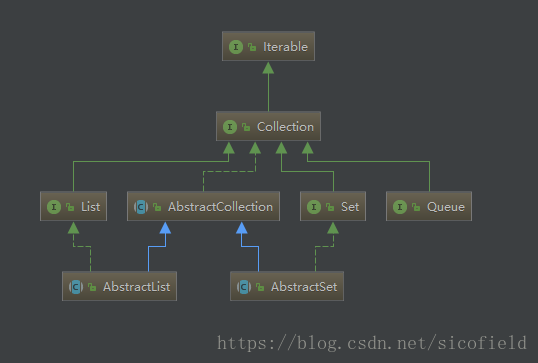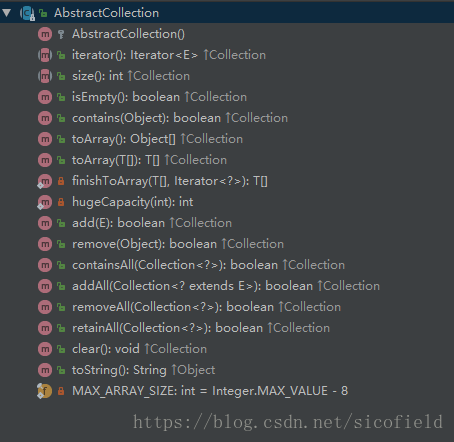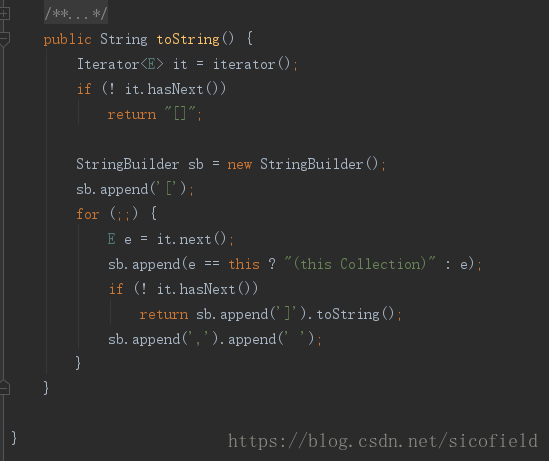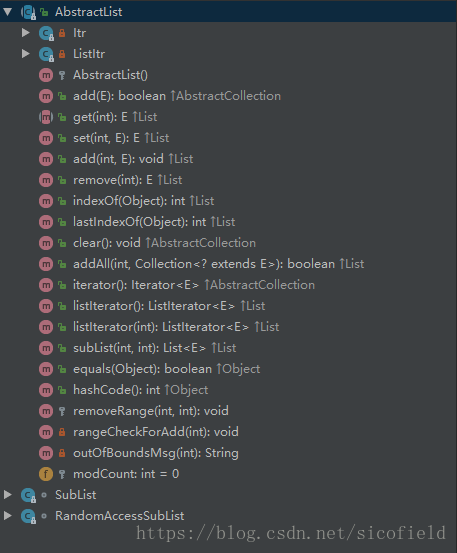上文Java集合框架剖析(1)分析了Collection上层的一些接口。
为了方便,Java抽象出AbstractCollection类来让其他类继承,该类实现类Collection中的绝大部分方法。AbstractList和AbstractSet都继承与AbstractCollection,具体的List实现类继承与AbstractList,而Set的实现类则继承与AbstractSet。
AbstractCollection
AbstractCollection是一个抽象类,它实现了Collection中除了iterator()和size()之外的所有方法。AbstractCollection的主要作用是方便其他类实现Collection.,比如ArrayList、LinkedList等。它们想要实现Collection接口,通过集成AbstractCollection就已经实现大部分方法了,再实现一下iterator()和size()即可。AbstractCollection的设计就是一个模板类。
Abstract的部分代码如下:
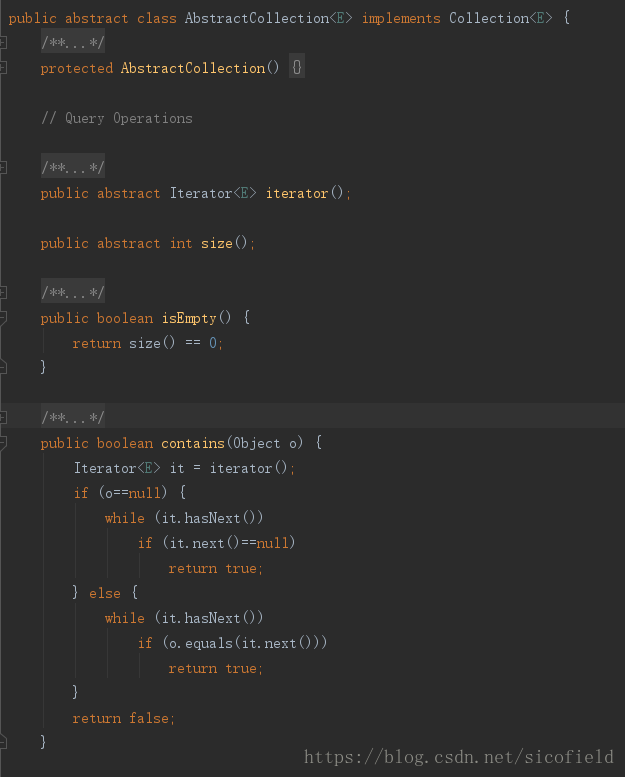
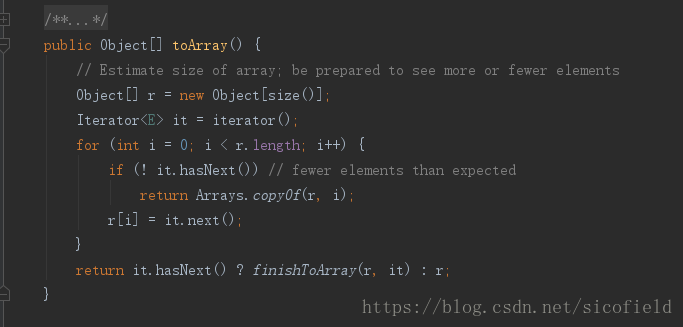
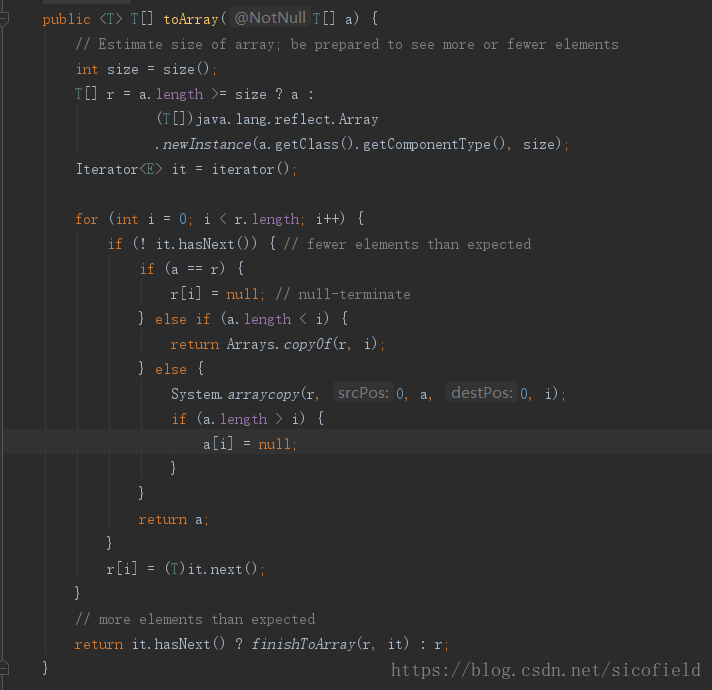
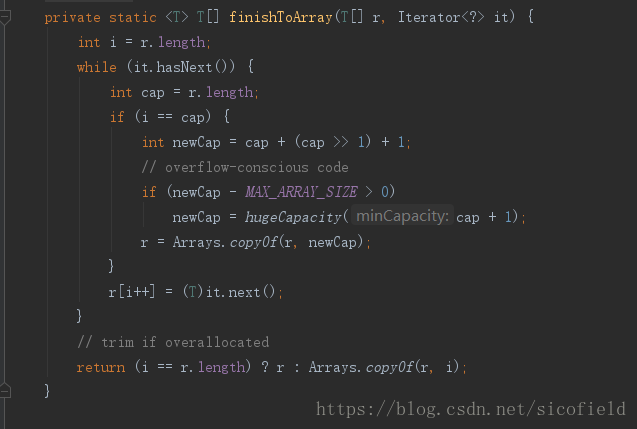

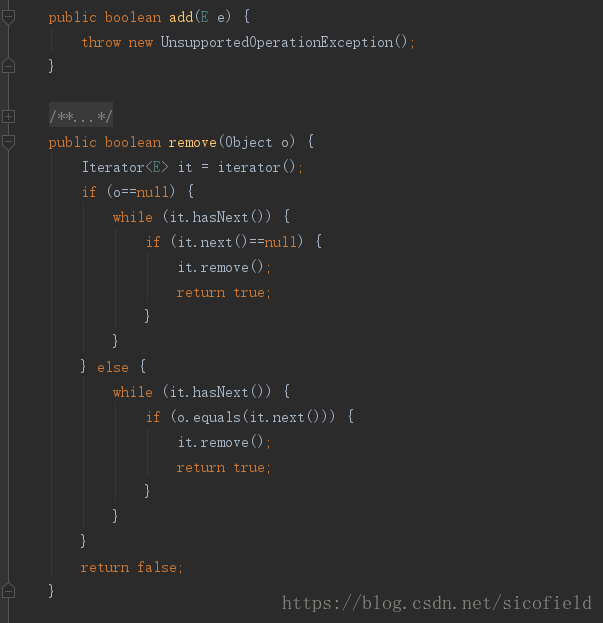
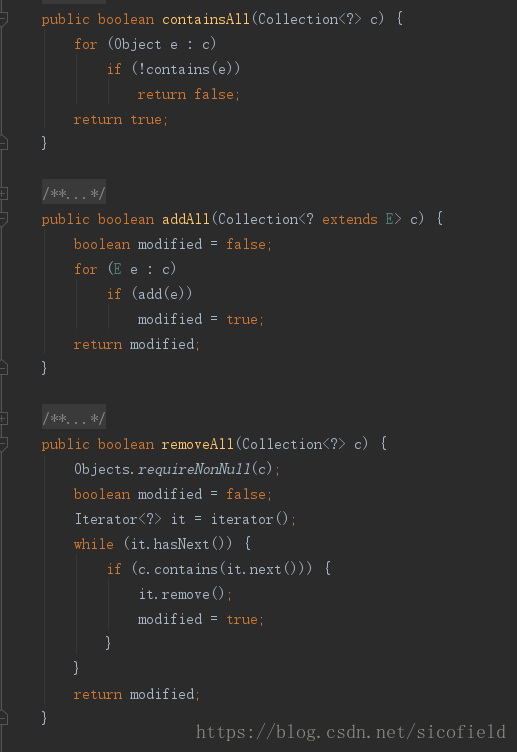
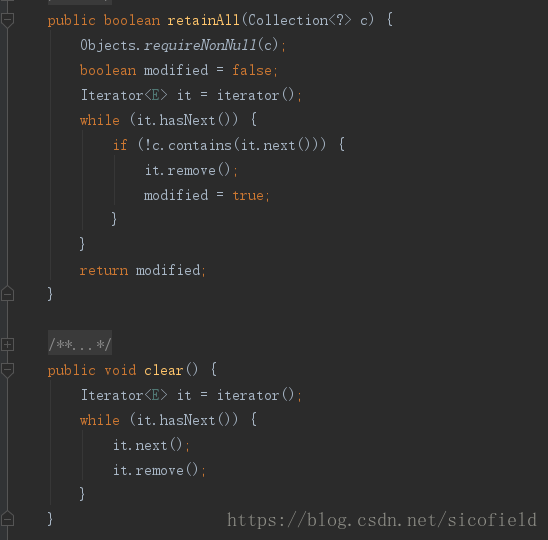
AbstractList

AbstractList是一个继承AbstractCollection,并且实现了List接口的抽象类。它实现了List中除了size()、get(int location)之外的方法。
AbstractList的主要作用:它实现了List接口中的大部分函数,从而方便其它类继承List。另外,和AbstractCollection相比,AbstractList抽象类中,实现了iterator()方法。
public abstract class AbstractList<E> extends AbstractCollection<E> implements List<E> {
protected AbstractList() {
}
public boolean add(E e) {
add(size(), e);
return true;
}
abstract public E get(int index);
public E set(int index, E element) {
throw new UnsupportedOperationException();
}
public void add(int index, E element) {
throw new UnsupportedOperationException();
}
public E remove(int index) {
throw new UnsupportedOperationException();
}
/***************************** Search Operations**********************************/
public int indexOf(Object o) { //搜索对象o的索引
ListIterator<E> it = listIterator();
if (o==null) {
while (it.hasNext())
if (it.next()==null) //执行it.next(),会先返回it指向位置的值,然后it会移到下一个位置
return it.previousIndex(); //所以要返回it.previousIndex(); 关于it几个方法的源码在下面
} else {
while (it.hasNext())
if (o.equals(it.next()))
return it.previousIndex();
}
return -1;
}
public int lastIndexOf(Object o) {
ListIterator<E> it = listIterator(size());
if (o==null) {
while (it.hasPrevious())
if (it.previous()==null)
return it.nextIndex();
} else {
while (it.hasPrevious())
if (o.equals(it.previous()))
return it.nextIndex();
}
return -1;
}
/**********************************************************************************/
/****************************** Bulk Operations ***********************************/
public void clear() {
removeRange(0, size());
}
public boolean addAll(int index, Collection<? extends E> c) {
rangeCheckForAdd(index);
boolean modified = false;
for (E e : c) {
add(index++, e);
modified = true;
}
return modified;
}
protected void removeRange(int fromIndex, int toIndex) {
ListIterator<E> it = listIterator(fromIndex);
for (int i=0, n=toIndex-fromIndex; i<n; i++) {
it.next();
it.remove();
}
}
/**********************************************************************************/
/********************************* Iterators **************************************/
public Iterator<E> iterator() {
return new Itr();
}
public ListIterator<E> listIterator() {
return listIterator(0); //返回的iterator索引从0开始
}
public ListIterator<E> listIterator(final int index) {
rangeCheckForAdd(index); //首先检查index范围是否正确
return new ListItr(index); //ListItr继承与Itr且实现了ListIterator接口,Itr实现了Iterator接口,往下看
}
private class Itr implements Iterator<E> {
int cursor = 0; //元素的索引,当调用next()方法时,返回当前索引的值
int lastRet = -1; //lastRet也是元素的索引,但如果删掉此元素,该值置为-1
/*
*迭代器都有个modCount值,在使用迭代器的时候,如果使用remove,add等方法的时候都会修改modCount,
*在迭代的时候需要保持单线程的唯一操作,如果期间进行了插入或者删除,modCount就会被修改,迭代器就会检测到被并发修改,从而出现运行时异常。
*举个简单的例子,现在某个线程正在遍历一个List,另一个线程对List中的某个值做了删除,那原来的线程用原来的迭代器当然无法正常遍历了
*/
int expectedModCount = modCount;
public boolean hasNext() {
return cursor != size(); //当索引值和元素个数相同时表示没有下一个元素了,索引是从0到size-1
}
public E next() {
checkForComodification(); //检查modCount是否改变
try {
int i = cursor; //next()方法主要做了两件事:
E next = get(i);
lastRet = i;
cursor = i + 1; //1.将索引指向了下一个位置
return next; //2. 返回当前索引的值
} catch (IndexOutOfBoundsException e) {
checkForComodification();
throw new NoSuchElementException();
}
}
public void remove() {
if (lastRet < 0) //lastRet<0表示已经不存在了
throw new IllegalStateException();
checkForComodification();
try {
AbstractList.this.remove(lastRet);
if (lastRet < cursor)
cursor--; //原位置的索引值减小了1,但是实际位置没变
lastRet = -1; //置为-1表示已删除
expectedModCount = modCount;
} catch (IndexOutOfBoundsException e) {
throw new ConcurrentModificationException();
}
}
final void checkForComodification() {
if (modCount != expectedModCount)
throw new ConcurrentModificationException();
}
}
private class ListItr extends Itr implements ListIterator<E> {
ListItr(int index) {
cursor = index;
}
public boolean hasPrevious() {
return cursor != 0;
}
public E previous() {
checkForComodification();
try {
int i = cursor - 1; //previous()方法中也做了两件事:
E previous = get(i); //1. 将索引向前移动一位
lastRet = cursor = i; //2. 返回索引处的值
return previous;
} catch (IndexOutOfBoundsException e) {
checkForComodification();
throw new NoSuchElementException();
}
}
public int nextIndex() { //iterator中的index本来就是下一个位置,在next()方法中可以看出
return cursor;
}
public int previousIndex() {
return cursor-1;
}
public void set(E e) { //修改当前位置的元素
if (lastRet < 0)
throw new IllegalStateException();
checkForComodification();
try {
AbstractList.this.set(lastRet, e);
expectedModCount = modCount;
} catch (IndexOutOfBoundsException ex) {
throw new ConcurrentModificationException();
}
}
public void add(E e) { //在当前位置添加元素
checkForComodification();
try {
int i = cursor;
AbstractList.this.add(i, e);
lastRet = -1;
cursor = i + 1;
expectedModCount = modCount;
} catch (IndexOutOfBoundsException ex) {
throw new ConcurrentModificationException();
}
}
}
/**********************************************************************************/
//获得子List,详细源码往下看SubList类
public List<E> subList(int fromIndex, int toIndex) {
return (this instanceof RandomAccess ?
new RandomAccessSubList<>(this, fromIndex, toIndex) :
new SubList<>(this, fromIndex, toIndex));
}
/*************************** Comparison and hashing *******************************/
public boolean equals(Object o) {
if (o == this)
return true;
if (!(o instanceof List))
return false;
ListIterator<E> e1 = listIterator();
ListIterator e2 = ((List) o).listIterator();
while (e1.hasNext() && e2.hasNext()) {
E o1 = e1.next();
Object o2 = e2.next();
if (!(o1==null ? o2==null : o1.equals(o2)))
return false;
}
return !(e1.hasNext() || e2.hasNext());
}
public int hashCode() { //hashcode
int hashCode = 1;
for (E e : this)
hashCode = 31*hashCode + (e==null ? 0 : e.hashCode());
return hashCode;
}
/**********************************************************************************/
protected transient int modCount = 0;
private void rangeCheckForAdd(int index) {
if (index < 0 || index > size())
throw new IndexOutOfBoundsException(outOfBoundsMsg(index));
}
private String outOfBoundsMsg(int index) {
return "Index: "+index+", Size: "+size();
}
}
class SubList<E> extends AbstractList<E> {
private final AbstractList<E> l;
private final int offset;
private int size;
/* 从SubList源码可以看出,当需要获得一个子List时,底层并不是真正的返回一个子List,还是原来的List,只不过
* 在操作的时候,索引全部限定在用户所需要的子List部分而已
*/
SubList(AbstractList<E> list, int fromIndex, int toIndex) {
if (fromIndex < 0)
throw new IndexOutOfBoundsException("fromIndex = " + fromIndex);
if (toIndex > list.size())
throw new IndexOutOfBoundsException("toIndex = " + toIndex);
if (fromIndex > toIndex)
throw new IllegalArgumentException("fromIndex(" + fromIndex +
") > toIndex(" + toIndex + ")");
l = list; //原封不动的将原来的list赋给l
offset = fromIndex; //偏移量,用在操作新的子List中
size = toIndex - fromIndex; //子List的大小,所以子List中不包括toIndex处的值,即子List中包括左边不包括右边
this.modCount = l.modCount;
}
//注意下面所有的操作都在索引上加上偏移量offset,相当于在原来List的副本上操作子List
public E set(int index, E element) {
rangeCheck(index);
checkForComodification();
return l.set(index+offset, element);
}
public E get(int index) {
rangeCheck(index);
checkForComodification();
return l.get(index+offset);
}
public int size() {
checkForComodification();
return size;
}
public void add(int index, E element) {
rangeCheckForAdd(index);
checkForComodification();
l.add(index+offset, element);
this.modCount = l.modCount;
size++;
}
public E remove(int index) {
rangeCheck(index);
checkForComodification();
E result = l.remove(index+offset);
this.modCount = l.modCount;
size--;
return result;
}
protected void removeRange(int fromIndex, int toIndex) {
checkForComodification();
l.removeRange(fromIndex+offset, toIndex+offset);
this.modCount = l.modCount;
size -= (toIndex-fromIndex);
}
public boolean addAll(Collection<? extends E> c) {
return addAll(size, c);
}
public boolean addAll(int index, Collection<? extends E> c) {
rangeCheckForAdd(index);
int cSize = c.size();
if (cSize==0)
return false;
checkForComodification();
l.addAll(offset+index, c);
this.modCount = l.modCount;
size += cSize;
return true;
}
public Iterator<E> iterator() {
return listIterator();
}
public ListIterator<E> listIterator(final int index) {
checkForComodification();
rangeCheckForAdd(index);
return new ListIterator<E>() {
private final ListIterator<E> i = l.listIterator(index+offset); //相当子List的索引0
public boolean hasNext() {
return nextIndex() < size;
}
public E next() {
if (hasNext())
return i.next();
else
throw new NoSuchElementException();
}
public boolean hasPrevious() {
return previousIndex() >= 0;
}
public E previous() {
if (hasPrevious())
return i.previous();
else
throw new NoSuchElementException();
}
public int nextIndex() {
return i.nextIndex() - offset;
}
public int previousIndex() {
return i.previousIndex() - offset;
}
public void remove() {
i.remove();
SubList.this.modCount = l.modCount;
size--;
}
public void set(E e) {
i.set(e);
}
public void add(E e) {
i.add(e);
SubList.this.modCount = l.modCount;
size++;
}
};
}
public List<E> subList(int fromIndex, int toIndex) {
return new SubList<>(this, fromIndex, toIndex);
}
private void rangeCheck(int index) {
if (index < 0 || index >= size)
throw new IndexOutOfBoundsException(outOfBoundsMsg(index));
}
private void rangeCheckForAdd(int index) {
if (index < 0 || index > size)
throw new IndexOutOfBoundsException(outOfBoundsMsg(index));
}
private String outOfBoundsMsg(int index) {
return "Index: "+index+", Size: "+size;
}
private void checkForComodification() {
if (this.modCount != l.modCount)
throw new ConcurrentModificationException();
}
}
class RandomAccessSubList<E> extends SubList<E> implements RandomAccess {
RandomAccessSubList(AbstractList<E> list, int fromIndex, int toIndex) {
super(list, fromIndex, toIndex);
}
public List<E> subList(int fromIndex, int toIndex) {
return new RandomAccessSubList<>(this, fromIndex, toIndex);
}
}AbstractSet

AbstractSet是一个继承与AbstractCollection,并且实现了Set接口的抽象类。由于Set接口和Collection接口中的API完全一样,所以Set也就没有自己单独的API。和AbstractCollection一样,它实现了List中除iterator()和size()外的方法。所以源码和AbstractCollection的一样。

AbstractSet的主要作用:它实现了Set接口中的大部分函数,从而方便其他类实现Set接口。
